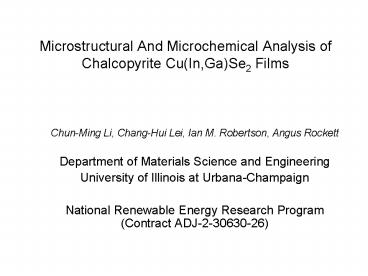Microstructural And Microchemical Analysis of Chalcopyrite CuIn,GaSe2 Films - PowerPoint PPT Presentation
1 / 18
Title:
Microstructural And Microchemical Analysis of Chalcopyrite CuIn,GaSe2 Films
Description:
Samples cut & glued face-to-face. Slices cut from the glued sandwiches. ... Glued to copper grids and ion milled to. transparency. Grinding. Ion. Milling ... – PowerPoint PPT presentation
Number of Views:121
Avg rating:3.0/5.0
Title: Microstructural And Microchemical Analysis of Chalcopyrite CuIn,GaSe2 Films
1
Microstructural And Microchemical Analysis of
Chalcopyrite Cu(In,Ga)Se2 Films
- Chun-Ming Li, Chang-Hui Lei, Ian M. Robertson,
Angus Rockett - Department of Materials Science and Engineering
- University of Illinois at Urbana-Champaign
- National Renewable Energy Research Program
(Contract ADJ-2-30630-26)
2
Efficiency of Shell Solar Cells 14 , Global
Solar Cells 10.
How to correlate the device performances with
microstructure and microchemistry?
3
- TEM specimen preparation
- Plan view Specimens
- Substrates thinned by mechanical grinding to
- 20-30 mm thickness.
- Ion milled from the back surface to electron
transparency. - Cross-sectional Specimens
- Samples cut glued face-to-face.
- Slices cut from the glued sandwiches.
- Slices thinned by mechanical grinding to
- 20-30 mm thickness.
- Glued to copper grids and ion milled to
- transparency.
Grinding
Ion Milling
4
Microstructure of Shell Solar Cell Samples
Plan view
5
Microstructure of Shell Solar Cell Samples
Cross-section
Dislocation density low and only in a few grains.
6
Microstructure of Global Solar Cell Samples
Plan view
Cross-section
7
- Cross-section microstructure
Microanalysis of Shell Solar Cell samples
8
Microanalysis of Shell Solar Cell samples
- EDS measurement
O and Na show no enrichment at grain boundaries!
9
Shell Solar Cells - Microchemistry
Correlation between O/Na and other elements
No obvious trend between O or Na with other
elements. Global Solar Cells have similar
results.
10
Shell Solar Cells - Microchemistry
Correlation between O and Na
- Primary conclusions from this work
- A very large scatter in the compositions of all
samples - 2. Linear relationship between O and Na ?
- (not with Global Solar Cells).
11
Ternary plots of all measurements- Shell Solar
Cells
Data points should lie along tie line but they
dont, 10 at. scatter.
12
Ternary plots of all measurements- Global Solar
Cells
(1) The Cu/In Ga/S Se compositions, without
the inclusion of oxygen, fall close to the ideal
112 ternary composition of CuInSe2. (2) No
difference between the composition in the grain
interiors and the grain boundary. (3) Oxygen
content of the Global Solar Cells is higher than
that of Shell Solar Cells.
13
High Resolution TEM of Swedish Solar Cell
Samples
CIGS twins
CIGS/CdS interface
Twin boundary
CIGS
CdS
Grain boundary
14
Swedish CIGS Solar Cell Sample Low Magnification
Image
HRTEM and HR Z-contrast area
15
CIGS/CdS Interface Structure of the Swedish
Solar Cell Samples
High Resolution TEM image
High Resolution Z-contrast image
One area
CdS
CIGS
CIGS
CdS
16
CIGS/CdS Interface Structure - continued
High Resolution TEM image
High Resolution Z-contrast image
Another area
CdS
CdS
CIGS
CIGS
1. STEM image is sensitive to atomic number (Z)
of atom - Z-contrast 2. Very useful and practical
technique for imaging heterogeneous crystals 3.
Combining with XEDS and EELS, it can detect the
atomic arrangement local bonding and
electronic structure with atomic resolution
17
Conclusions
- (1) No common extended defects other than
occasional - twins in grains.
- (2) Dislocations are very rare.
- (3) No strong depth or composition dependence of
defect - density.
- (4) No composition difference grain interiors ?
grain - boundaries.
- (5) No obvious enhancement of O and Na at grain
boundaries. - (6) The Cu/(In Ga)/(S Se) compositions ? tie
line. - Both fall close to CuInSe2.
- (The Shell Solar sample is slightly less
group III-rich. - The GSE sample has a higher group III
content.) - (7) Very large scatter in the compositions, 10
at. variation. - (8) Z-contrast is very useful and practical
technique for imaging heterogeneous interfaces
for the solar cell.
18
ACKNOWLEDGEMENTS 1. The U.S. Department of
Energy. The Office of Basic Energy Sciences
(Contract No. DEFG02-91ER45439) 2. The Center
for Microanalysis of Materials at UIUC3. The
National Renewable Energy Laboratory (Contract
ADJ-2-30630-26).































